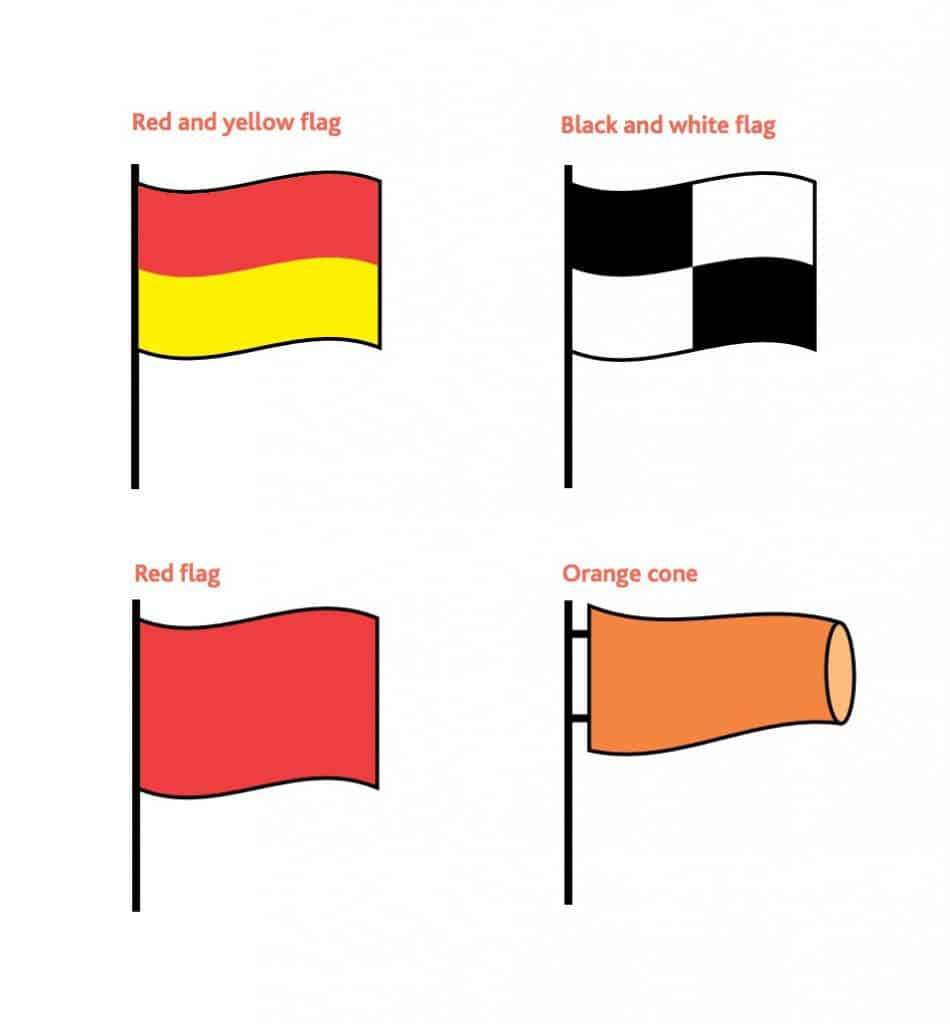So you want to take your kids to the seaside, but how do you know if a beach is safe to swim in the sea?
This falls to three key points:
- Lifeguards
- The water quality
- Water conditions
Not all beaches have lifeguards and measure the water quality. If you are not confident, it is best to stick to beaches with lifeguards or visit those with a Blue Flag award, where information is available to make an informed decision.
Lifeguards
The main beaches in the UK have lifeguards during the summer season, typically from Easter to the end of September.
These beaches have information points at the main beach entrance and also display flags on the beach. If you visit the beach for the first time, then you should be reading the information board.

Red and Yellow Flag
It shows a swimming and bodyboarding zone that has a lifeguard patrol and is safe to swim in the sea.
Black and White Flag
Shows a zone or boundary of a zone designated for the use of surfboards and other watercraft.
Red Flag
The sea should be avoided, which means dangerous conditions unsafe for swimming and other activities.
Orange Cone
An orange cone indicates when the wind and/or water conditions make it unsafe for inflatables.
If in doubt, always ask a lifeguard.
The Water Quality
The water quality at designated sites is assessed weekly, and the current water quality is measured against the standards set in the European Bathing Water Directive. Tests are only during the Summer, from May to the end of September. As well as the weekly tests, annual ratings classify each site based on samples from the previous four years.
The current bathing water quality information is displayed on the beach information board, and the ratings are:
- Excellent – the highest, cleanest class (also the standard required for a Blue Flag)
- Good – generally good water quality
- Sufficient – the water meets minimum standards
- Poor – the water has not met the new minimum standards. Bathing waters classified as poor will have the “advice against bathing” advice throughout the following season.
Using standardised symbols for the four classes, which all countries in the EU have to use at bathing waters across Europe, will help people make informed choices on where to swim. The symbols are as follows:

The water quality is only a guideline and a beach displaying a “poor” classification is only advice against bathing, it does not mean swimming is banned or that a beach is closed.
The Water Conditions
In the UK, the three main water conditions to be aware of are cold water, rip currents and waves.

Cold water
Swimmers can get cold water shock when water temperatures are lower than 15⁰C (59⁰F), and in UK and Irish seas, the average temperature is 12⁰C (54⁰F).
Thus, even in the Summer, the water temperature is cold enough to cause cold water shock. This can take the air from your lungs and leave you helpless. Swimmers, bodyboarders, or surfers planning to spend a lot of time in the sea should invest in a wet suit. Wetsuits don’t have to be expensive, and often, local shops and surf schools sell or even rent them out.
Rip currents
Rip currents, often called “rips”, are strong currents running out to sea that can quickly drag people away from the beach and to deeper water. These currents are often found in larger surf conditions and near river mouths, estuaries and structures like piers and groynes.
Rip currents can be tricky to spot, so don’t be afraid to ask lifeguards for advice. If no lifeguards are on the beach, then ask other people in the sea as they may have local knowledge. But remember, never, never go into the sea alone.
If you do find yourself caught in a rip:
- Swimmers should never swim against the flow as you’ll get exhausted. The current can flow between 1 and 5 mph, which will even beat an Olympic swimmer. The rip is often narrow, and you should try to swim parallel to the shore until you are free of the rip and then head back to the beach.
- The sea might not be that deep if you can stand then wade rather than swim.
- Gain attention by raising your hand and shouting for help.
Waves
The main influencers to the size and power of a wave is how strong the wind is, how long it has been blowing, where it comes from and how steeply a beach slopes or shelves.
The best surfing beaches in the UK are around Cornwall and parts of south Wales where a south-west wind will bring waves from across the Atlantic Ocean, and this is because the wave has had a long time and distance uninterrupted in the sea.
The right kinds of waves offer a lot of fun, but always stay mindful of your own limits.
Remember, treat water with respect and never underestimate the power of water
Our beach information pages give details on lifeguards and for English and Welsh beaches give the water quality results where a test site exists on the beach.
